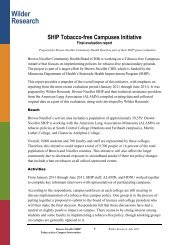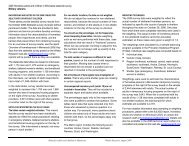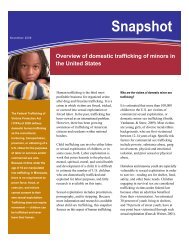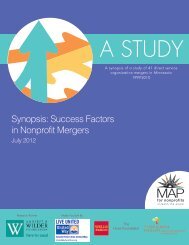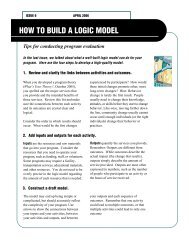Success Factors in Nonprofit Mergers - Minnesota Council of ...
Success Factors in Nonprofit Mergers - Minnesota Council of ...
Success Factors in Nonprofit Mergers - Minnesota Council of ...
You also want an ePaper? Increase the reach of your titles
YUMPU automatically turns print PDFs into web optimized ePapers that Google loves.
<strong>Success</strong> <strong>Factors</strong><br />
<strong>in</strong> nonpr<strong>of</strong>it mergers<br />
<strong>Factors</strong> proven to make nonpr<strong>of</strong>its mergers more likely to succeed<br />
3. Survival versus strategy motivations <strong>in</strong> merger<br />
Frequency Percent<br />
Strategy-only 3 7%<br />
Strategy-lean<strong>in</strong>g 6 15%<br />
Balanced 20 49%<br />
Survival-lean<strong>in</strong>g 8 20%<br />
Survival-only 4 10%<br />
Almost one-half (49%) <strong>of</strong> the mergers studied are considered to have balanced<br />
motivations for merger. This means that the number <strong>of</strong> survival motivations is equal to<br />
or with<strong>in</strong> one <strong>of</strong> the number <strong>of</strong> strategy motivations reported for at least one <strong>of</strong> the premerger<br />
organizations <strong>in</strong> Figure 3. For example, if a merger reports that three <strong>of</strong> the strategy<br />
motivations and two <strong>of</strong> the survival motivations were primary reasons for merger <strong>in</strong> at least<br />
one <strong>of</strong> the pre-merger organizations, this merger would be considered to have balanced<br />
motivations for merger.<br />
Ten percent <strong>of</strong> the mergers are considered survival-only. This means that they identified<br />
all three survival motivations <strong>in</strong> at least one <strong>of</strong> the pre-merger organizations and none<br />
<strong>of</strong> the strategy motivations. Conversely, seven percent <strong>of</strong> the mergers are considered<br />
strategy-only. F<strong>in</strong>ally, one-fifth (20%) <strong>of</strong> the mergers are considered survival-lean<strong>in</strong>g and<br />
15 percent were strategy-lean<strong>in</strong>g. These represent mergers that were motivated more by<br />
either survival or strategy, but still had some elements <strong>of</strong> both.<br />
Expand<strong>in</strong>g types or reach <strong>of</strong> services<br />
A key strategic motivation for pursu<strong>in</strong>g merger is to expand the types <strong>of</strong> services the<br />
organization <strong>of</strong>fers or to expand the market reach (geographic or segment) <strong>of</strong> the<br />
services the organization <strong>of</strong>fers. In this study, more than half (56%) <strong>of</strong> the mergers<br />
were seen as an opportunity to expand the reach <strong>of</strong> services to new markets, client<br />
populations, or new geographies. A much smaller percentage (29%) reported that they<br />
wished to expand the type <strong>of</strong> services <strong>of</strong>fered.<br />
Improv<strong>in</strong>g programs and provid<strong>in</strong>g better service<br />
At the core <strong>of</strong> strategic motivations for purs<strong>in</strong>g merger is the potential to improve<br />
programs and services. Respondents from two-thirds (66%) <strong>of</strong> the mergers studied<br />
described elements related to better serv<strong>in</strong>g clients, customers, or members or improv<strong>in</strong>g<br />
the services the organization provides. The primary ways <strong>in</strong> which organizations were<br />
seek<strong>in</strong>g to better serve clients was to reduce confusion because <strong>of</strong> duplicate services or<br />
providers and, <strong>in</strong> general, provid<strong>in</strong>g better access to services.<br />
<strong>Success</strong> <strong>Factors</strong> In <strong>Nonpr<strong>of</strong>it</strong> <strong>Mergers</strong> 27 MAP for <strong>Nonpr<strong>of</strong>it</strong>s & Wilder Research 2012



